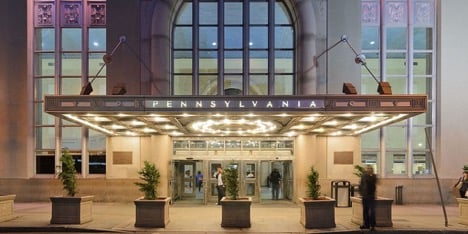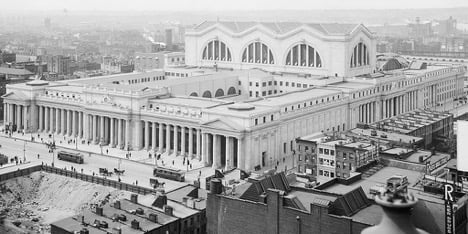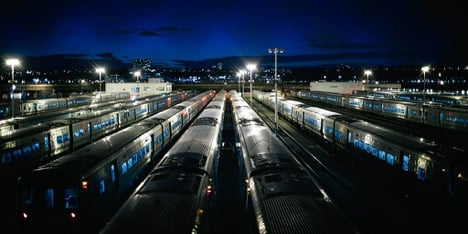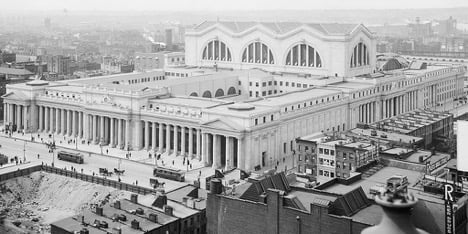Pennsylvania Station, also known as New York Penn Station or simply, Penn Station is the main intercity rail station in New York City. It is the busiest rail station in the Western Hemisphere, carrying 630,000 passengers per weekday. It is located in midtown Manhattan between 7th and 8th Avenues and 31st and 33rd Streets near Herald Square, Koreatown, Macy’s flagship store and the Empire State Building. What many people may not know is that the Station sits below Madison Square Garden.

King of Hearts [CC BY-SA 4.0 (https://creativecommons.org/licenses/by-sa/4.0)], from Wikimedia Commons
The original 8-acre structure opened in 1910 and is quite different from the current building on the same site with its mazes of underground tunnels. Penn Station is named for the Pennsylvania Railroad (PRR), which touted itself at the turn of the 20th century as, “the standard railroad of the world.” PRR commissioned the design and construction and was the building’s first tenant.
The Station was a solution to a nagging problem for commuters at the time that was preventing the Railroad from offering truly great customer service; that problem was the Hudson River. Before Penn Station, trains stopped at the edge of the Hudson River in New Jersey. Manhattan-bound passengers had to disembark and take a ferry to traverse the Hudson. Unfortunately for riders, the disembarkation venue also served as the main shipping port, so rail passengers leaving the trains experienced very chaotic conditions.
PRR President, Alexander Cassatt, considered a few options, including a bridge across the Hudson River between 45th and 50th Streets in Manhattan and two separate stations for the PRR and the Long Island Railroad. However, after careful consideration, Cassatt modified the plans to utilize a tunnel instead of a bridge at one-third the projected cost. He chose Charles Jacobs, an English engineer who designed tunnels under New York’s East River and conducted a feasibility study for the tunnel proposal, to oversee the project. PRR then acquired 28 additional acres of land in a “seedy” neighborhood, known as the Tenderloin, for the tunnel construction. The next task was to find architects for the Station.
Known as the firm that defined the look of Gilded Age America, McKim, Mead and White was selected to design an impressive gateway to the city. Taking inspiration from the Roman Baths of Caracalla, the Bank of England, and the Vatican’s Bernini Piazza, McKim and his colleagues chose the Beau-Arts style with several columns, a 148-foot coffered ceiling, and iron and glass canopies over the platforms. While it appeared to be constructed from solid granite, 650 granite-encased steel columns supported the structure.
The origin of Beaux-Arts style is the Ecole des Beaux-Arts (School of Fine Arts) in France where many architects of the 19th and early 20th century studied. Emphasizing classical Greek and Roman forms and features, elaborate detailing, and heavy masonry, Beaux-Arts designs usually featured highly decorated surfaces, grand Roman arches and colossal columns or pilasters.

Pennsylvania Station 1910
Detroit Publishing Company [Public domain], via Wikimedia Commons
When the Station finally opened in 1910, The New York Times proclaimed it as the largest building ever built at one time. The Times article also noted that the structure could be expanded to meet higher demand, noting that the population of New York City would reach 8 million by 1920.
As part of the terminal's construction, PRR proposed that the United States Postal Service construct a post office across from the station on the west side of 8th Avenue. The government agreed in 1903 and made plans to build the Farley Post Office. PRR would build a train storage yard in Queens to be used by both PRR trains from the west and LIRR (Long Island Railroad) trains from the east. The yard's purpose was to store passenger rail cars at the beginning or end of their trips.
The initial capacity of Penn Station was 144 trains per hour on 21 tracks and 11 platforms for a total of 1,000 trains each weekday. 600 of them were LIRR trains, the other 400 were PRR trains. LIRR riders’ commute times were shortened by up to 30 minutes. Due to demand, the PRR soon added 51 trains to its daily schedule. By 1917, the Station also served New Haven trains to Westchester County and Connecticut. During its 53-year operation, many intercity passenger trains arrived and departed daily to Chicago and St. Louis, where arriving passengers could connect to other railroads. A side effect of the tunneling project was to open the city up to the suburbs. Ten years after opening, two-thirds of the daily passengers coming through Penn Station were commuter.
By the end of World War II and into the 1950s, however, non-commuter passenger traffic was in decline as air travel was becoming popular. PRR acknowledged the shift in consumer preference by selling the air rights to the property and shrinking the station. By 1960, the building had deteriorated, and demolition of the original structure began in 1963. The final pieces of façade were removed two years later. While there wasn’t significant public resistance to the demolition then, about 200 people did protest in front of the Station in 1962.
The replacement of Penn Station in the late ‘60s after the demolition of the original structure resembled a catacomb with large rooms and several hallways. Criticized as a charmless, subterranean chamber with no natural light and poor ventilation, even the improvements in the 1990s, which included air conditioning, closer taxis, brighter lighting, and more stores, did little to change people’s perception of the new building. In 2012, the New York Times quoted now retired sportscaster, Vince Scully, as commenting, “To commute via the bowels of Penn Station . . . is a humiliation.”

Penn Station by Travis Leech licensed under CC BY-NC-ND 2.0
With increased interest in preservation and historic landmarks, a movement is afoot to reconstruct Penn Station to its former glory. Rebuild Penn Station is an organization with a mission to “dramatically enhance the quality of life in the metropolitan New York City area by rebuilding Pennsylvania Station as the centerpiece of a new world-class transportation network for the entire region.” The group’s Master Plan calls for a new high-tech transportation hub that connects two commuter railroads, two subways, and Amtrak, as well as rebuild of the surrounding neighborhood to make the area a world-class destination.
Though there are competing schools of thought about the overburdened station, given the significant public and private interest in the movement to rebuild, and the President’s remarks about spending over a trillion dollars in infrastructure in the U.S., likely something is on the horizon for Penn Station.◊
.jpg?width=600&name=MIlrose-blos-Penn-Station_2%20(1).jpg)







